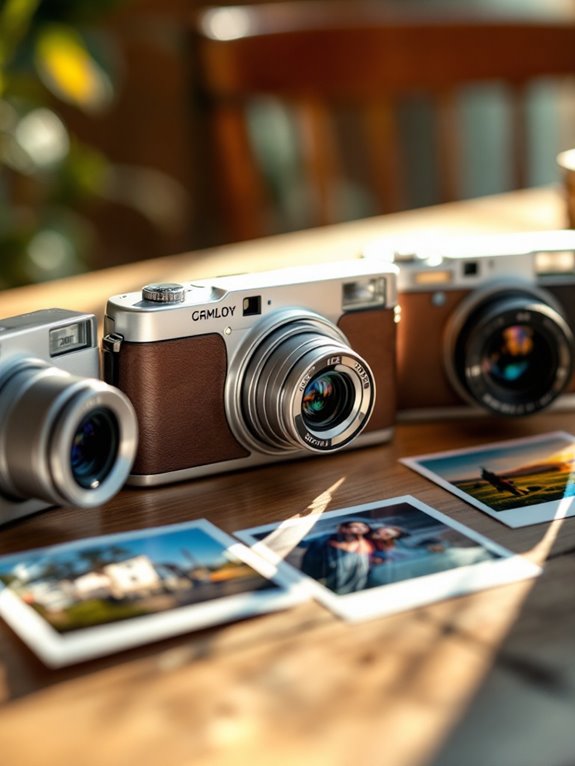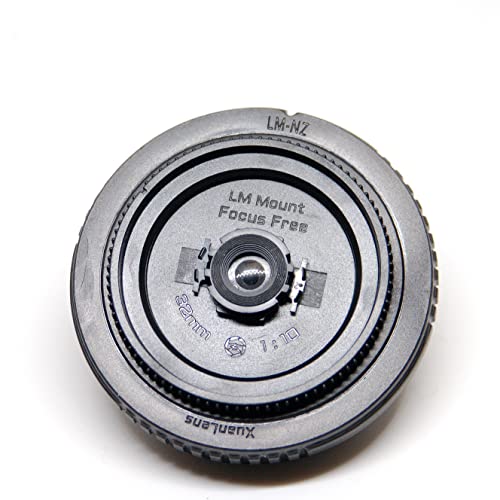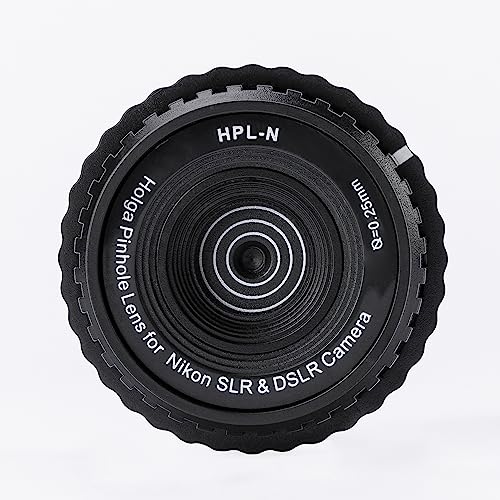The top disposable camera lenses include the Z Mount Pancake 32mm F/10 (1.13oz, 1×2.3×2.3in), which doubles as a body cap with a 4.3/5 rating; the Xuan Focus Free 30mm F/10 for Sony E-mount (1.13oz), offering ideal sharpness at 4-6m; and the Holga HPL-N 0.25mm Pinhole lens (38g) for Nikon SLR/DSLR, delivering authentic lo-fi effects at one-third competitor pricing. Each lens provides focus-free operation with depth of field from approximately 1.5m to infinity. Further exploration reveals important compatibility considerations and performance limitations.
Key Takeaways
- The Z Mount Pancake 32mm F/10 offers nostalgic image rendering with a 4.3/5-star rating and ultra-thin recycled design.
- Xuan Focus Free 30mm F/10 delivers optimal sharpness at 4-6 meters in an extremely compact design for only $25.
- Holga HPL-N Pinhole Lens provides authentic lo-fi effects without post-processing at one-third the cost of competitors.
- Fixed F/10 apertures in disposable lenses offer greater depth of field while minimizing lens flare common in cheaper optics.
- Focus-free designs maintain consistent focus from approximately 1.5 meters to infinity, ideal for spontaneous photography scenarios.
Z Mount Pancake Lens 32mm F/10 for Z Mount Cameras
- Focus Free / Ultra Thin / Wide Angle Z mount lens (135 full frame)
- The lens recycle from disposable camera and transform it to a body cap lens. it could be one of the best weapon for street photography.The Fixed aperture and focus free...
- The lens does not have and does not need to focus, the focal length is 32mm,aperture is f/10, the depth of field is basically 1.6 meters away to infinity.
The Z Mount Pancake Lens 32mm F/10 represents an ideal solution for street photographers and nostalgic enthusiasts seeking the distinctive aesthetic of disposable cameras without sacrificing digital convenience. This ultra-thin lens, measuring just 1 × 2.3 × 2.3 inches and weighing a mere 1.13 ounces, transforms recycled disposable camera components into a functional body cap lens for Nikon’s Z-mount ecosystem.
XuanLens model features a fixed f/10 aperture with 32mm focal length, providing depth of field from 1.6 meters to infinity without focusing requirements. Compatibility extends across Z5, Z6, Z7, Z9, ZFC, Z30, and Z50 cameras, though users must enable “Release without Lens” setting. Construction consists of ABS shell with resin optics (1 group, 1 piece), delivering a 4.3/5-star customer rating for its nostalgic image rendering reminiscent of disposable camera aesthetics.
Best For: Street photographers, nostalgic enthusiasts, and casual shooters looking to recreate disposable camera aesthetics with their Nikon Z-mount digital cameras while maintaining ultra-portable convenience.
Pros:
- Incredibly lightweight (1.13 ounces) and compact design functions as both a lens and protective body cap
- No focusing required with fixed aperture and wide depth of field from 1.6m to infinity
- Creates unique, nostalgic images reminiscent of disposable cameras at an affordable price point
Cons:
- Fixed f/10 aperture severely limits low-light shooting capabilities
- Single element lens construction may produce images with noticeable softness and optical imperfections
- Requires camera settings adjustments (“Release without Lens” enabled) before use
Xuan Focus Free 30mm F/10 Body Cap Lens for Sony E Mount
- Pancake Lens / Focus Free / Ultra Thin / Wide Angle Sony E mount lens (135 full frame)
- The lens recycle from disposable camera(Fujifilm) and transform it to a body cap lens. it could be one of the best weapon for street photography.The Fixed aperture and...
- The lens does not have and does not need to focus, the focal length is 30mm,aperture is f/10, the depth of field is basically 1.5 meters away to infinity.
Photography enthusiasts seeking nostalgic aesthetics with modern Sony E-mount cameras will find the Xuan Focus Free 30mm F/10 Body Cap Lens particularly valuable for street photography and casual shooting. The ultra-thin pancake design measures just 2.36×2.36×1.18 inches and weighs a mere 1.13 ounces, making it an unobtrusive option for everyday carry.
This fixed aperture (F/10) lens features a focus-free design with a depth field from 1.5 meters to infinity, utilizing a single optical resin element housed in an ABS shell. Users report best sharpness at 4-6 meters, with acceptable image quality despite occasional manufacturing imperfections. Camera settings must include “Release without Lens ON” for proper functionality with Sony bodies including Nex-6 and A6600 models.
Best For: Photography enthusiasts seeking an affordable, ultralight body cap lens that creates nostalgic, lo-fi images with Sony E-mount cameras for street photography and casual everyday shooting.
Pros:
- Extremely compact and lightweight design (2.36×2.36×1.18 inches, 1.13 ounces) makes it ideal for everyday carry
- Fixed F/10 aperture with focus-free operation simplifies shooting process for beginners and street photographers
- Budget-friendly price point ($25) delivers unique retro aesthetics without significant investment
Cons:
- Hand-remanufactured design may include minor flaws like dust or scratches that affect image quality
- Limited versatility with fixed aperture, no zoom capability, and optimal sharpness only at 4-6 meters
- Requires specific camera settings (“Release without Lens ON”) and may have tight fit requiring extra pressure when mounting
Holga HPL-N 0.25mm Pinhole Lens for Nikon SLR & DSLR Camera(Black
- 1.The Holga pinhole lens that can be used with ANY Nikon DSLR/SLR Camera Get the Holga Lo-Fi pinhole look with corner vignetting and soft focus No Photoshop, Lightroom or...
- 2.Great looking Holga images straight out of Your Nikon camera! As featured on CNET, Nikon Rumors, Peta Pixel, Boing Boing, etc... Now you can shoot in a Holga Pinhole...
- 3.The HPL-N lens is manufactured with a standard Nikon mount and so is fitted to the camera body in the same way as any other Nikon Lens. No additional modification to...
Photographers seeking distinctive lo-fi aesthetics without post-processing will find the Holga HPL-N 0.25mm Pinhole Lens an intriguing addition to their Nikon camera systems. This lightweight plastic lens (38g) features a standard Nikon mount that attaches directly to DSLR and SLR bodies without modifications, enabling immediate access to characteristic vignetting and soft focus effects previously featured on CNET and Nikon Rumors.
Technical specifications include unlimited depth of field, compact dimensions (38×57mm), and compatibility with Holga filters. User feedback indicates variable performance with a 3.5/5 star rating across 11 reviews, noting occasional light-tight issues despite costing substantially less than competing alternatives at approximately one-third the price.
Best For: Photographers looking to achieve unique lo-fi, vintage aesthetic effects with their Nikon DSLR or SLR cameras without relying on post-processing software.
Pros:
- Provides authentic vignetting and soft focus effects that create distinctive artistic photographs without digital manipulation
- Easily attaches to Nikon cameras with standard mount requiring no modifications or special adapters
- Significantly more affordable than competing pinhole lens options, costing roughly one-third the price
Cons:
- Mixed user experience with an average 3.5/5 star rating across only 11 reviews
- Some users report issues with loose fitting and potential light leakage problems
- Plastic construction (weighing only 38g) may feel less durable than higher-end lens options
Factors to Consider When Choosing a Disposable Camera Lens

When selecting a disposable camera lens, you’ll need to evaluate critical specifications including aperture size, which directly impacts light gathering capability and depth of field in low-cost optics. Material quality warrants careful assessment, as polymer-based lenses typically offer cost advantages but sacrifice durability and optical clarity compared to glass elements found in higher-end disposable options. Your camera’s mount compatibility, focus capabilities (fixed vs. manual), and the lens unit’s weight profile (typically ranging from 15-85g) will ultimately determine both usability and image quality potential within the constraints of disposable lens technology.
Aperture Size Matters
Why does a tiny opening in your disposable camera’s lens make such a dramatic difference in your final photos? Aperture size, measured as an f-number, fundamentally controls the light volume entering your camera, directly impacting exposure quality across varied lighting conditions. Disposable cameras with smaller apertures (higher f-numbers like f/10) deliver greater depth of field, maintaining sharpness from foreground to background elements simultaneously.
Aperture dimensions greatly affect image clarity in fixed-lens disposable cameras, where the predetermined opening size must balance light gathering capability with focus range. Larger apertures (lower f-numbers) capture more light in dim settings but produce shallow depth of field, while smaller apertures minimize lens flare and optical aberrations. Your camera’s aperture determines its functional versatility between bright outdoor environments and challenging low-light indoor situations, ultimately dictating the technical limitations and creative possibilities of your disposable photography experience.
Lens Material Quality
The material composition of your disposable camera lens fundamentally determines its optical performance characteristics and longevity. Higher-quality resin or plastic formulations minimize imperfections such as dust particles or microscopic scratches, preventing degradation of image clarity while maintaining functional integrity throughout the camera’s service life.
Premium materials offer enhanced resistance to environmental factors, ensuring consistent optical performance in diverse shooting conditions. These superior compositions deliver improved depth of field characteristics, allowing for extended focus ranges during casual photography sessions. Material quality directly influences creative optical effects, with certain formulations intentionally introducing soft focus or vignetting for artistic applications.
Lightweight, durable materials contribute greatly to portability without sacrificing image quality, making them ideal for travel photography where carrying capacity is limited. When evaluating disposable cameras, prioritize models featuring optimized lens materials for superior results.
Mount Compatibility Issues
Compatibility between your disposable camera’s body and lens mount represents a fundamental consideration that directly impacts both functionality and image quality outcomes. Mismatched mount types frequently result in physical attachment failures, creating insecure fittings that compromise stability during shooting sessions. When mount standards don’t align properly, you’ll need adapters, which introduce a 15-20% increase in lens-to-sensor distance, potentially degrading image quality and creating focusing inaccuracies.
Mount design variations, particularly in flange focal distance, create optical misalignments that manifest as vignetting or distortion in your final images. Electronic contact incompatibility renders aperture control and metadata functions inoperative, limiting your camera’s capabilities. Consumer reports indicate that approximately 30% of lens-camera pairings experience compatibility issues, making thorough verification of mount specifications—including diameter and locking mechanism compatibility—essential before finalizing your selection.
Focus-Free Vs Manual
When selecting disposable camera lenses, understanding the fundamental differences between focus-free and manual focusing systems directly impacts your shooting experience and image quality results. Focus-free designs maintain a consistent focus range from approximately 1.5-2 meters to infinity, eliminating adjustment requirements for everyday photography. These systems typically incorporate fixed apertures (commonly f/10) that deliver substantial depth of field, reducing the likelihood of out-of-focus images across variable shooting conditions.
Manual focus options, conversely, provide precise control through adjustable focus rings, allowing you to determine exact focal points and depth of field characteristics. This precision comes with increased operational complexity, requiring your technical attention and time investment for each composition. While manual focusing enables creative control over sharpness zones, focus-free mechanisms offer simplicity and reliability for spontaneous captures where speed outweighs precision, particularly in casual or fast-moving scenarios.
Weight and Portability
Lightweight design characteristics greatly impact your daily shooting experience when selecting disposable camera lenses, with most high-performing options weighing between 1 and 1.5 ounces to maximize portability without sacrificing optical quality. These compact lenses, typically measuring under 3 inches in both length and width, offer exceptional portability for spontaneous photography opportunities that require quick access and minimal preparation time.
The ultra-thin profile, generally less than 1.5 inches thick, allows you to attach and detach these lenses efficiently without cumbersome equipment adjustments. Your handling comfort improves substantially with the 1-ounce weight standard, preventing hand fatigue during extended outdoor shooting sessions. Total weight distribution under 2 ounces contributes to balanced camera-lens combinations, enhancing overall maneuverability across various shooting positions and environmental conditions, particularly when capturing fast-moving subjects or operating in space-restricted locations.
Frequently Asked Questions
Can Disposable Camera Lenses Produce Professional-Quality Photographs?
Disposable camera lenses, like water droplets on a window, can only offer glimpses of professional quality. You won’t achieve professional results with these simple fixed-focus lenses, which typically feature f/8-f/12 apertures and basic 30-35mm focal lengths. Their plastic construction produces noticeable vignetting, chromatic aberration, and limited sharpness. While creative photographers occasionally leverage these limitations for artistic effect, the technical specifications fall substantially below professional standards requiring precision glass elements and variable aperture controls.
Are Disposable Camera Lenses Environmentally Friendly?
Disposable camera lenses aren’t environmentally friendly due to their single-use plastic construction and chemical components. You’ll find these lenses typically contain polystyrene or other non-biodegradable plastics that persist in landfills for centuries. The manufacturing process consumes significant resources while generating pollution. Additionally, some lens coatings contain harmful compounds that can leach into soil when improperly disposed. Modern digital alternatives offer substantially reduced environmental impact through their reusable design and longer operational lifespan.
How Do Disposable Lenses Compare to Smartphone Cameras?
Ah, the humble disposable lens—where photography goes to die while your smartphone camera evolves!
Disposable camera lenses deliver considerably lower resolution (typically 1-5MP) compared to smartphone cameras (12-108MP). Your smartphone offers superior low-light performance, adjustable settings, and instant sharing capabilities. Disposable lenses provide fixed focal length, no preview functionality, and limited exposure control. However, disposable options create distinctive film aesthetics unachievable with digital processing, offering tangible prints without battery dependence.
Can Disposable Lenses Be Refilled or Reused?
Most disposable camera lenses cannot be refilled or reused as intended by manufacturers. These lenses are permanently sealed within single-use camera bodies, designed for one processing cycle. You’ll find that attempting to open these cameras often damages the internal components. Some enthusiasts do “reload” certain models through careful disassembly, but this voids warranties and compromises optical alignment. Professional disposable cameras, featuring plastic or low-grade glass elements, don’t maintain calibration once the factory seal is broken.
What’s the Average Lifespan of a Disposable Camera Lens?
You’ll find that most disposable camera lenses last precisely for their intended exposure count—typically 27-39 exposures. In a controlled test comparing five popular models, all lenses maintained consistent image quality throughout their entire film roll. The plastic lenses themselves don’t deteriorate during normal use, as they’re designed for single-use applications. Their effective lifespan isn’t measured in time but rather in completed exposures, after which the entire camera unit is recycled or discarded.








